SAT Subject Test Physics (2012)
PART III. PHYSICS TOPIC REVIEW
Chapter 14. MAGNETISM
When you think of magnets, you may consider locker magnets, refrigerator magnets, and children’s toys. However, the applications of magnets extend far beyond these simple devices. Magnets are the basic elements of devices from doorbells to power stations. Understanding the principles of magnetism will enable you to answer a variety of questions on SAT Physics.
Magnets
The effects of a magnet are strongest in two regions, known as the poles, called the north pole and the south pole. The names arise from the fact that a magnet suspended by its midpoint and allowed to swing freely will become oriented such that one pole faces the north and the other faces the south. Three common types of magnets are shown here.
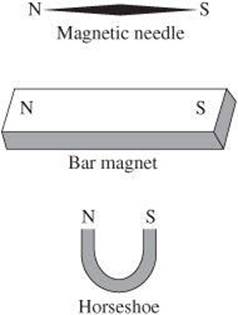
Just as the law of charges described the interaction of like and unlike charges, the law of magnets describes the interaction of magnetic poles. Like magnetic poles repel one another, and unlike magnetic poles attract one another.
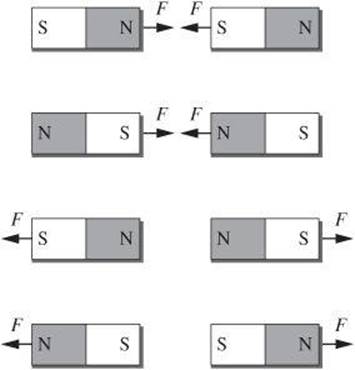
A major difference between magnetic poles and electric charges is that magnetic poles cannot be isolated. Magnetic poles always occur in pairs. If a magnet were cut in half, each portion would have both a north pole and a south pole. Some materials are naturally magnetic. Lodestone is a rock that acts as a natural magnet. Other materials can be made into magnets by stroking them with a permanent magnet. A magnet is described as soft if it is easily magnetized but also tends to lose its magnetism easily. Iron is a soft magnetic material. A hard magnetic material is difficult to magnetize but tends to retain its magnetism. Cobalt and nickel are examples of hard magnetic materials.

Magnetic Field
The concept of an electric field was described around electric charge. Similarly, a magnetic field is described around magnets. The direction of the magnetic field B is the direction in which the north pole of a compass needle would point if placed in a particular location. The magnitude of the magnetic field is greatest near the poles and decreases as the distance from the poles increases. The magnetic field can be described by magnetic field lines, as shown in the following diagram, as well as iron filings sprinkled around a magnet. As you can see, magnetic field lines do not overlap. Instead, they form closed loops from the north pole to the south pole outside the magnet. Iron filings are convenient for demonstrating the magnetic field around a magnet. The diagram on the left shows how to draw the field, and the diagram on the right shows how iron filings become aligned in the presence of a bar magnet.
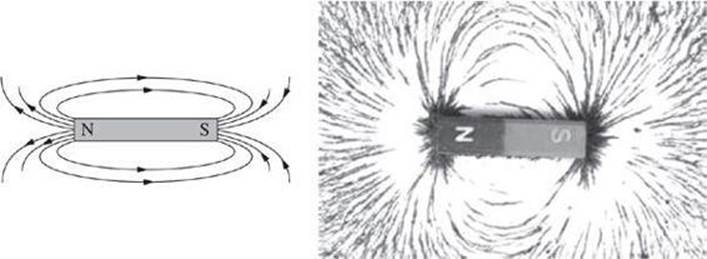
As in the case of electric charges, magnetic fields interact due to the attraction and repulsion between magnetic poles. The following diagram shows how magnetic fields are altered.
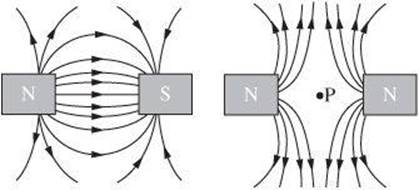
In diagrams and questions, and X is used to show that B is directed into the page, a dot is used to show that B is directed out of the page, and an arrow is used to show that B is along the plane of the page.

Compasses are useful because Earth behaves as if it had a giant bar magnet through its center. It has a magnetic field extending from one pole to the other. However, the magnetic poles do not line up exactly with the geographic poles. The difference between the geographic pole and the direction toward which a compass points is described as magnetic declination. The location of magnetic north varies over time, and the magnetic declination varies with location.
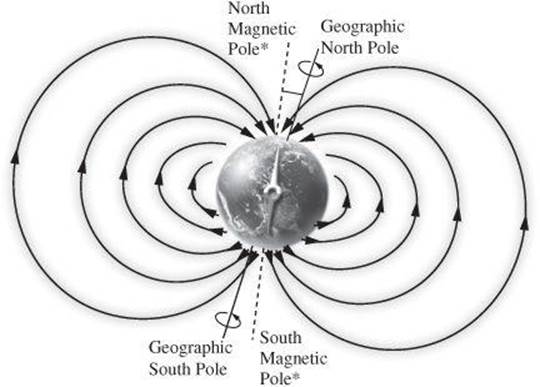
Electromagnetism
If a wire carrying current is passed through a sheet of plastic with iron filings on it, the filings become arranged in circles around the wire. The reason for this is that an electric current establishes a magnetic field around it. This relationship between electricity and magnetism is known as electromagnetism. If, instead of iron filings, compasses were placed around the wire, the direction of the magnetic field could be investigated. You could easily observe that when the direction of the current is reversed, the directions of the compass needles are also reversed. The direction of the magnetic field can be determined using the right-hand rule. If the wire were held with the right hand such that the thumb is in the direction of the current, the fingers curl in the direction of B. The magnitude of B is proportional to the current in the wire and inversely proportional to the distance from the wire.
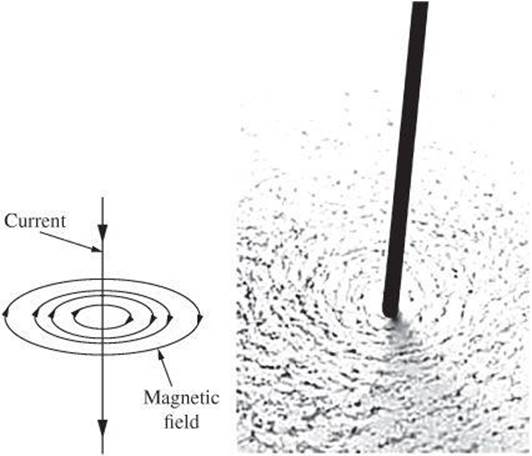
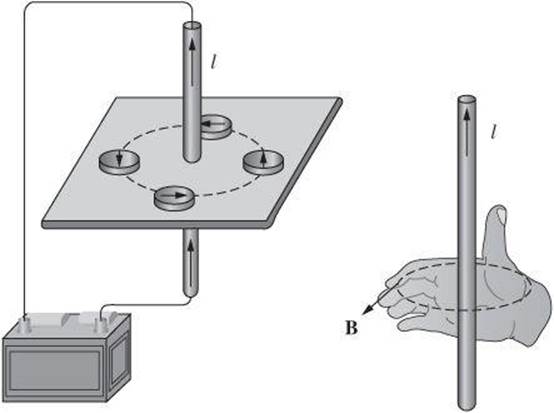
If the wire is wound into a coil, the magnetic field resembles the field around a bar magnet. A series of closely spaced coils of wire is known as a solenoid. The magnetic field of a solenoid depends on the current in the wire as well as the number of coils. As the current and or the number of coils increases, the strength of the solenoid increases. The strength can also be increased by inserting an iron rod into the center. A solenoid with an iron core is known as an electromagnet. Electromagnets have many useful applications because the strength can be controlled and the magnet can be turned on and off using a switch.

Magnetic Domains
A model of domains is often used to explain the magnetic properties of materials. The electrons of atoms within the material are described as spinning. (The actual motion of electrons will be better explained by quantum mechanics.) The spinning motion produces a tiny magnetic field. The fields of electrons with opposite spins cancel out. For nonmagnetic materials, most or all of the fields cancel out. For magnetic materials, however, the fields do not cancel out completely. Large groups of atoms with net spins that align form domains. If the material is placed in the magnetic field of a magnet, some of the domains can become aligned. The more domains that become aligned, the stronger the magnetic field will be.
In hard magnetic materials, this alignment continues after the magnetic field is removed. The material then becomes a permanent magnet. In soft magnetic materials, the domains return to their original (unaligned) positions once the field is removed. The alignment of domains can also be destroyed if a magnet is dropped, hit, or heated.

Magnetic Force
A charged particle moving through a magnetic field experiences a magnetic force Fm. No force is exerted if the charged particle is stationary. The magnitude of the force is maximum when the charge is moving perpendicular to the magnetic field and zero when the particle moves along magnetic field lines.
The magnetic force exerted on a positive charge q moving at velocity v perpendicular to the field is described by the following equation.
![]()
When force is measured in newtons, charge in Coulombs, and velocity in meters per second, the unit of the magnetic field strength is the tesla T. The strength of the magnetic field is often referred to as magnetic flux Φ.
The right-hand rule is again used to find the direction of the magnetic force on a positive charge. This time, extend your fingers in the direction of B and your thumb pointing in the direction of v. The direction of the magnetic force will extend out of the palm of your hand. This rule is sometimes described as the second right-hand rule.

An electric current is made up of a stream of moving charges. Therefore, a current-carrying wire experiences a magnetic force just as a single charge does. The resultant force is the sum of the individual forces on the particles. The magnitude of the total magnetic force for a segment of straight wire L carrying current I in a uniform magnetic field B is described by the following equation.
![]()
Note that the equation assumes the current is at an angle of 90° to the magnetic field. If not, the equation becomes the following, where θ is the angle between the wire and the magnetic field.
![]()
Example:
A current of 30 A travels through a wire with a length of 0.20 m between the poles of a magnet at an angle of 45°. If the magnetic field has a uniform value of 0.2 T, what is the magnitude of the force on the wire?
![]()
Electromagnetic Induction
Just as an electric current can establish a magnetic field, a magnetic field can be made to induce an electric current. The key is that the magnetic field must be changing. Either the magnet must be moving with respect to a current-carrying wire or the wire must be moving with respect to the magnet. The process through which an electric current can be induced by a changing magnetic field is known as electromagnetic induction.

When a voltage is generated by a magnetic force, the voltage is traditionally described as the electromotive force, or emf. It is not actually a force, but instead represents the energy per unit charge made available by the source. The emf can be described by the following equation, where L is the length of the wire, v is the relative speed, and B is the magnetic field strength.
![]()
As you can see from the equation, you can increase the magnitude of the emf by increasing the length of the wire moving through the field, the relative speed, or the strength of the magnetic field.
Generator
A loop of wire turning within a magnetic field induces a current because of the relative motion between the wire and the field. The mechanical energy used to turn the loop of wire is therefore transformed into electrical energy. A device capable of this type of transformation is known as a generator. In electric power plants, the mechanical energy might be supplied from steam produced by burning coal or from nuclear reactions. It might also be supplied by falling water, wind, or even tidal changes.
It will be helpful to be familiar with basic technology related to generators. The armature is the power-producing component, which is the wire through which the current is induced. The armature is mounted on a rotate shaft. A commutator is a device that maintains the direction of the current. Carbon brushes are devices that transfer current between the stationary parts of a generator and the moving parts. A split ring is a metal ring that connects parts together.
DC Generator When the armature is vertical, such that the area of the loop is perpendicular to the magnetic field, the wire is moving parallel to the field, and, therefore, no current is induced in the wire. As it rotates, the segments of wire move relative to the magnetic field, so a current is induced. The current is maximum when segments of the loop have rotated 90° and move perpendicularly relative to the magnetic field. The loop continues to rotate as the current decreases down to zero. The current always flows in the same direction and is known as direct current, or DC. This type of generator is therefore known as a DC generator.
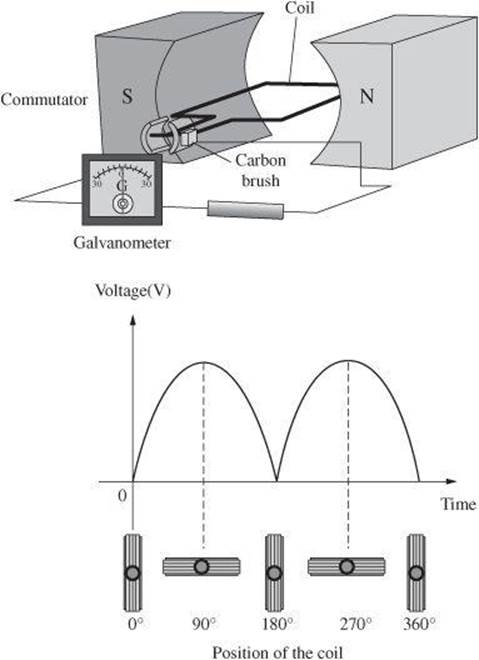
AC Generator If the commutator is replaced by two separate slip rings, the direction of the current keeps changing. The current is known as alternating current, or AC, and the generator is known as an AC generator.
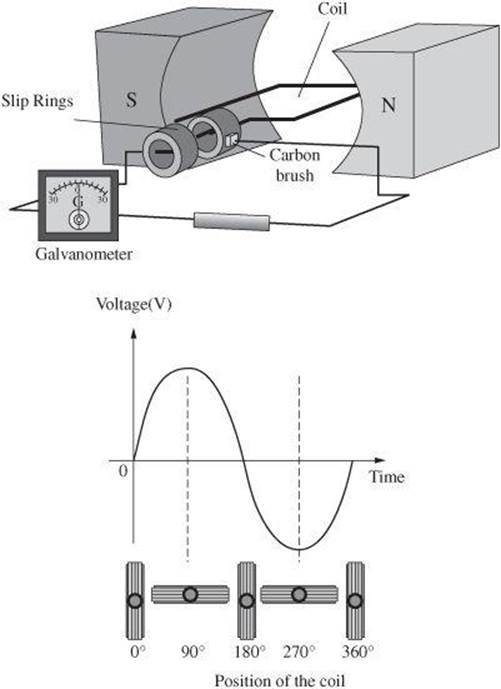
Motors
A motor is the reverse of a generator. Electrical energy converted to mechanical energy is a motor. A current is supplied to the wire in a magnetic field by an external source, such as a battery. Because the current is flowing in opposite directions on each side of the wire loop, the two sides of the wire loop experience forces in opposite directions. This difference establishes a torque that causes the loop to rotate. The armature can be connected to a shaft that can be used to do work.
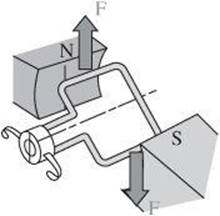
Test-Taking Hint
Be aware when using the right-hand rules that you are using conventional current. It developed from Benjamin Franklin, who theorized that electric current arose from the flow of positive charges moving from the positive terminal of a battery to the negative terminal.
REVIEW QUESTIONS
Select the choice that best answers the question or completes the statement.
1. What would be the result of cutting a magnet in half?
(A) both magnetic poles would be destroyed.
(B) each half would have two identical poles.
(C) one end of each half would not have a magnetic pole.
(D) each half would have a north pole and a south pole.
(E) each half would have two magnetic poles on each end.
2. What is the cause of magnetic declination?
(A) Earth constantly rotates on its axis.
(B) Earth’s magnetic poles are different from the geographic poles.
(C) Earth’s distance from the sun varies throughout its elliptical orbit.
(D) Earth’s circumference is greatest at the equator and smallest near the poles.
(E) Earth’s axis tilts at an angle of about 23° relative to the plane of its orbit.
3. A negative charge is placed in the magnetic field shown, which is directed out of the page. In which direction will the magnetic force on the charge be exerted?
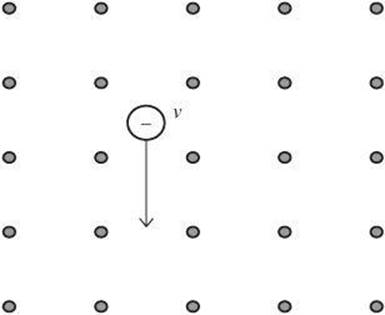
(A) upward
(B) downward
(C) to the left
(D) to the right
(E) into the page
4. A proton enters a magnetic field directed out of the page traveling from left to right. The resulting path of the proton is a circle. What is the radius of the circle in terms of the mass of the particle m, the velocity v, the charge q, and the magnetic field B?
(A) mvBq
![]()
![]()

![]()
5. A wire carries current coming directly out of the page. Which of the following describes the magnetic field produced by the wire?
(A) counterclockwise around the wire
(B) clockwise around the wire
(C) coming out of the page
(D) directed into the page
(E) perpendicular to the wire in both directions
6. A wire carrying a current of 6.0 A is placed in a magnetic field of 0.3 T such that the current flows at an angle of 90° to the field. The length of the wire is 0.2 m. What is the magnitude of the force on the wire?
(A) 0.36 N
(B) 0.60 N
(C) 1.2 N
(D) 1.8 N
(E) 6.5 N
7. A proton moving east experiences a force of 7.2 × 10–19 N upward as a result of Earth’s magnetic field. If the speed of the proton is 2.0 × 105 m/s, what is the magnitude of the magnetic field at this location? (Assume that Earth’s magnetic field is essentially true north in this location.)
(A) 1.4 × 10–6 T
(B) 2.3 × 10–5 T
(C) 3.6 × 10–5 T
(D) 4.5 × 10–5 T
(E) 5.2 × 10–4 T
8. In which direction will the force on the wire be directed?
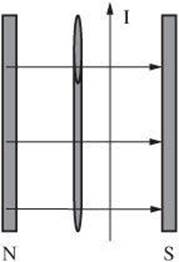
(A) into the page
(B) out of the page
(C) to the right
(D) to the left
(E) toward the top of the page
Questions 9 and 10 relate to the diagram below, which shows an electric generator.
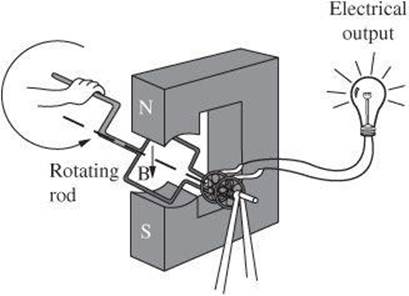
9. Which transformation takes place in the generator shown?
(A) chemical energy to electrical energy
(B) heat energy to mechanical energy
(C) electrical energy to mechanical energy
(D) electrical energy to heat energy
(E) mechanical energy to electrical energy
10. How can the emf of a generator be increased?
(A) reverse the poles of the permanent magnet
(B) increase the rate at which the wire moves through the magnetic field
(C) shorten the length of the wire moving through the field
(D) reduce the strength of the magnetic field through which the wire moves
(E) maintain the wire in a stationary position
QUESTION ANSWERS AND EXPLANATIONS
1. D Magnetic poles cannot exist independently. Every magnet has both a north pole and a south pole. Therefore, cutting a magnet in half would result in two complete smaller magnets, each with a north and south pole.
2. B Magnetic declination describes the difference between the direction a compass points and geographic north. It arises from the fact that the geographic poles are different from the magnetic poles, and it varies with location and time.
3. D Using the second right-hand rule, extend your fingers in the direction of B and your thumb pointing in the direction of v. The direction of the magnetic force on a positive test charge will extend out of the palm of your hand. The direction of the magnetic force on a negative test charge will be in the opposite direction.
4. E If the proton moves in a circle, the magnetic force (qvB) must equal the centripetal force ![]() Therefore,
Therefore, ![]() . Rearranging to solve for r shows that
. Rearranging to solve for r shows that ![]() .
.
5. A The direction of the magnetic field can be determined using the right-hand rule. If the wire were held with the right hand such that the thumb is in the direction of the current, the fingers curl in the direction of B.

6. ![]()
7. ![]()
8. C Use the second right-hand rule to determine the direction. Extend your fingers in the direction of the magnetic field, which is to the right. Point your thumb upward in the direction of the current. The force extends from the palm of your hand.
9. E An electric generator operates when the armature is turned. The motion of the armature requires mechanical energy. As the wire moves through the magnetic field, an electric current is induced. Therefore, electrical energy is produced. The mechanical energy is transformed into electrical energy.
10. B The induced emf is directly proportional to the length of the wire, the relative speed, and the magnitude of the magnitude field according to the equation ![]() . The only change listed that would increase emf would be to increase the rate, or speed, at which the wire moves relative to the field.
. The only change listed that would increase emf would be to increase the rate, or speed, at which the wire moves relative to the field.